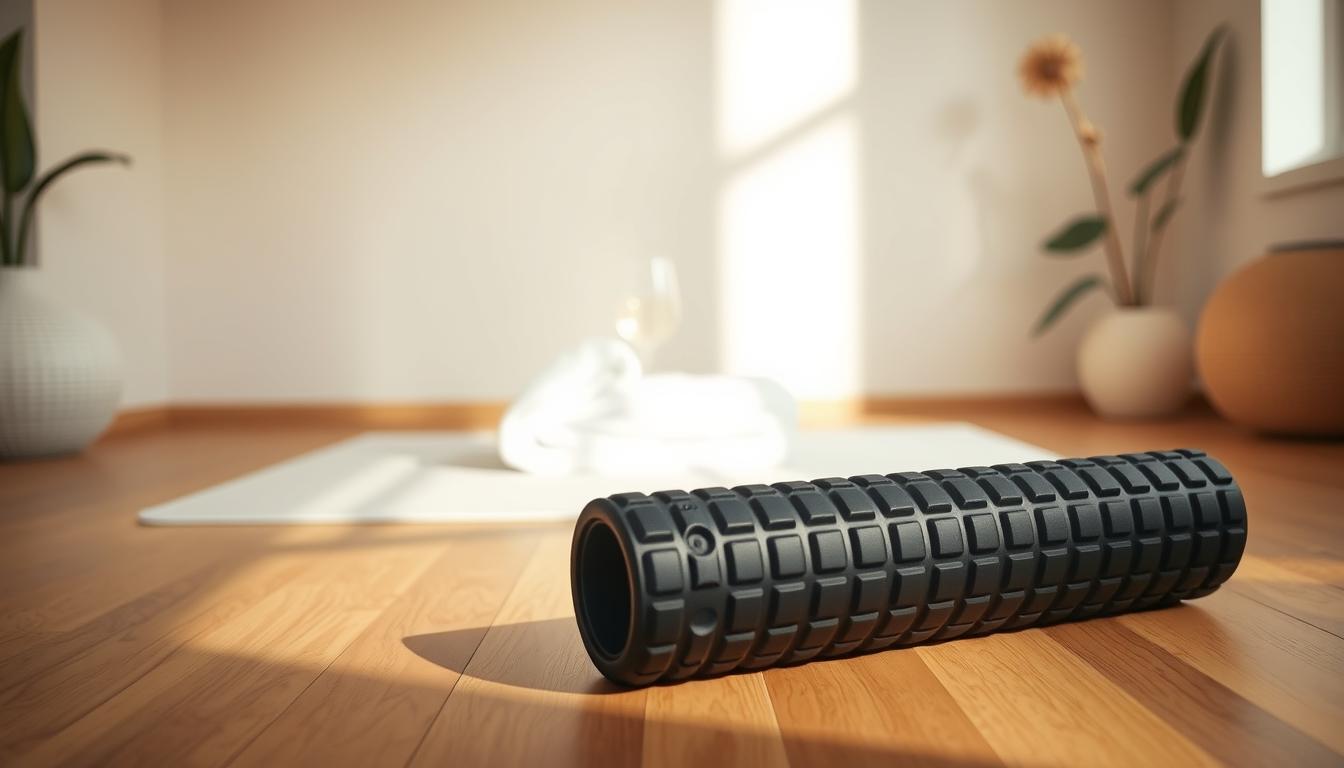If you’re a busy professional with a desk job, it’s important to stretch your neck and shoulders. Sitting for a long time can cause discomfort and stiffness. But with easy exercises, you can become more flexible and productive. These quick stretches can be done right at your desk, helping to ease tension fast.
Understanding the Impact of Sedentary Work on Neck and Shoulders
Sedentary work has a big effect on our neck and shoulder health. Many people with desk jobs suffer from health issues. These come from sitting too much and not moving enough. Studies show that 80% of American workers have discomfort from bad posture and doing the same movements over and over.
Sitting too long without moving can cause serious muscle and bone problems. Bad sitting habits can make posture worse, leading to pain in the neck and shoulders. Stress from staying in awkward positions too long adds to this tension. It’s important to understand how desk jobs affect our health so we can take steps to improve it.
Making small changes and paying attention can really help reduce these risks. Adding stretches and breaks throughout the day can make a big difference. Taking care of these issues is good for your body and your overall happiness.
Signs of Stress and Tension in Your Neck and Shoulders
Knowing the signs of neck tension is key for those with busy jobs. You might feel stiffness, ongoing pain, and less movement in your neck and shoulders. These are signs that work stress may be getting to you and hurting your work performance.
Spotting signs of shoulder pain is just as important. This kind of tension can make your whole upper body hurt, making daily tasks hard. If you notice these signs, it’s time to act to avoid worse health issues. Early action means doing stretches that can make you feel better and improve your work life.
The Importance of Regular Stretching for Busy Professionals
Stretching is key for those who sit a lot at work. It does more than just loosen your muscles; it boosts your overall health. By stretching often, you can move better and avoid getting hurt.
Stretching every day is crucial for feeling energetic and clear-headed. It helps with staying upright and not slouching, especially if you sit at a desk all day. Making it a part of your routine can make you work better, as you’re less tense and stressed.
Research shows stretching can cut pain by up to 72%. This makes working easier and improves the mood at work. So, adding stretching to your busy day helps ease pain and makes work life better.
Neck and Shoulder Stretch Routine for Busy Professionals
In today’s fast work life, taking short breaks for desk stretches can boost comfort and productivity. Quick exercises like shoulder shrugs and neck rolls are perfect for busy folks. They not only make you more flexible but also ease muscle tension throughout the day.
Quick Stretches You Can Do at Your Desk
Here’s a list of simple stretches you can do without leaving your desk:
- Shoulder Shrugs: Lift your shoulders towards your ears, hold for a moment, and release.
- Neck Rolls: Gently move your head in circles. Change direction after a few rolls.
- Forward Bends: Sitting down, bend forward with a straight back. This stretches your neck and shoulders.
Effective Techniques for Reducing Muscle Tension
To get the most out of these stretches, focus on breathing right and keeping your body aligned. Breathe in deeply before stretching, and exhale as you go into the stretch. Good posture helps relieve muscle tension and prevents discomfort. Doing these regularly can really improve your day in terms of comfort and productivity.
Incorporating Stretching into Your Daily Routine
Adding a regular stretching routine to your daily life greatly improves your physical and mental health. This is especially true for those who are always on the go. Stretching regularly fights the downsides of sitting too long. It keeps you healthy at work, helping you stay productive and focused. To make sure you take these breaks, setting reminders is a good idea.
Setting Reminders for Stretching Breaks
Using tech to remind you to stretch is a smart way to keep moving. Here’s how to make sure you remember:
- Use a mobile app designed for workplace health tips that prompts you to take breaks.
- Set alarms on your phone or computer to signify stretching times, ensuring you stick to your routine.
- Incorporate calendar invites that remind you to stretch, treating these breaks as important meetings for your health.
- Share your commitment with colleagues to create a supportive environment for stretching breaks.
If you take time to stretch during the day, you’ll feel better. Your health and work performance will improve. Plus, you’ll reduce neck and shoulder aches.
Simple Neck Stretches to Relieve Discomfort
Sitting at a desk for too long can cause neck pain. It’s important to do easy neck stretches often. These stretches help ease the pain by working your muscles and making them more flexible.
Here are some basic exercises to try:
- Chin Tucks: Sit or stand up straight, and pull your chin back toward your neck. Hold it there for five seconds, and do it ten times. This exercise makes your neck muscles stronger and improves your posture.
- Side Tilts: Lean your head to one side, aiming to touch your shoulder with your ear. Keep it like that for ten seconds, then do the other side. It stretches your neck’s side muscles.
- Upper Trap Stretch: Keep your back straight while sitting or standing. Tilt your right ear to your right shoulder and place your right hand on the left side of your head gently. Hold for fifteen seconds and enjoy the stretch in your neck. Then, do the same on the opposite side.
Doing these neck stretches several times a day can reduce tension and pain. With regular practice, you’ll see a big improvement in your neck’s health.
Shoulder Stretches for Increased Flexibility
Adding shoulder stretches to your daily routine is crucial. They help prevent stiffness and enhance flexibility. Doing these exercises makes your shoulders more flexible and eases pain.
This lets you move your shoulders more freely in your everyday tasks. Here are some good stretches to try:
- Cross-Body Stretch: Gently pull one arm across your chest using the opposite hand. Hold for 15-30 seconds, allowing the shoulder to relax.
- Shoulder Rolls: Sit or stand straight, lift your shoulders towards your ears, roll them back, and drop them down. Repeat this motion ten times to release tension.
- Child’s Pose: Kneel on the floor, sit back on your heels, and stretch your arms forward on the ground. This pose helps stretch the spine and shoulders, providing a calming effect.
Starting a routine with these stretches can greatly improve how your shoulders move. Doing these regularly helps prevent injuries. It also makes for a better work environment.
Combining Stretching with Posture Improvement
Having good posture is key to avoid pain in the neck and shoulders. This is true especially for those sitting at desks for hours. Stretching and focusing on how you sit can ease this tension. It also boosts your overall health. Good posture practices can make your workdays better and lessen body strain.
Learning how stretching and posture work together can improve your desk space. Making small changes to how you sit and work habits helps your body align better. This can make your whole workday more comfortable.
Tips for Maintaining Proper Posture at Your Desk
- Ensure your chair supports your lower back, promoting a natural curve.
- Adjust your monitor height so the top of the screen is at or slightly below eye level.
- Keep your feet flat on the floor; consider using a footrest if needed.
- Position your keyboard and mouse within easy reach to maintain relaxed shoulders.
- Incorporate frequent stretching and posture adjustments during your work hours.
Following these posture tips can help make your workspace healthier. Stretching regularly and being aware of your posture can balance your work routine. This approach reduces discomfort.
Additional Strategies to Combat Workplace Stress
Including different strategies helps ease stress at work. Taking active breaks is key in managing stress. Short walks or light activity during breaks can relieve body tension. Studies show stepping away from your desk boosts productivity and creativity.
Mindfulness makes a big difference in feeling good emotionally. Techniques like deep breathing or brief meditation sessions clear the mind and lessen anxiety. Adding these into your daily routine improves focus and helps you handle work stress better.

Using ergonomic furniture leads to healthier work habits. Chairs and desks that fit well reduce discomfort and improve posture. Changing your workspace can greatly improve your overall health, showing small changes bring big rewards.
It’s crucial to look at health broadly, including physical, emotional, and mental aspects. Understanding how these areas connect helps us make better choices for our wellbeing at work. Even small changes can make work life more balanced and enjoyable.
Conclusion
Neck and shoulder stretching is vital for professionals in desk jobs. This article showed how important it is to know about the tension that builds up. Adding a stretching routine to your day can make a big difference in how you feel and work.
Stretching at work has big benefits. It can ease pain and make you more flexible, making your workday better. Pay attention to what your body needs. Add stretching to your daily schedule. This can help you avoid the downsides of sitting too much at work.
Small steps like taking quick stretching breaks can improve neck and shoulder comfort. Start making these changes now. Your dedication to stretching will lead to a healthier and more productive work life.



